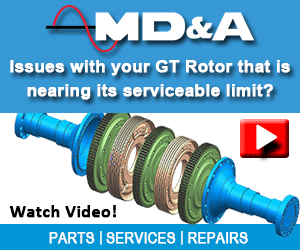 Summaries of MD&A’s spring 2022 webinars on topics of interest to all involved in the operation and maintenance of generating plants powered by gas turbines follow. Both experienced personnel and those new to the industry might benefit from a quick read to identify topics of immediate value and then follow up by listening to recordings of the webinars of interest. All run less than an hour.
Summaries of MD&A’s spring 2022 webinars on topics of interest to all involved in the operation and maintenance of generating plants powered by gas turbines follow. Both experienced personnel and those new to the industry might benefit from a quick read to identify topics of immediate value and then follow up by listening to recordings of the webinars of interest. All run less than an hour.
To access MD&A’s library of webinar recordings, go to MD&A Webinar Library and register for access.
Take a deep dive into failures, repairs of generator retaining rings, main leads
Retaining rings (RR) and main leads are two of the most stressed components in large combined-cycle generators and thus prone to failures. James Joyce, generator repairs ops manager for MD&A, during a Feb 24, 2022 webinar, covered the basic design and purposes of these two components, along with what can only be called gruesome photos of what they look like when in disrepair or fail from mechanical and/or electrical issues.
MD&A has developed repairs and upgraded components, which should be considered as replacements when maintenance intervals allow. The slides depict the design, manufacturing, and installation process for these upgraded parts.
The many audience questions elicited additional valuable contributions to the presentation, including the following:
- There is no such thing as “severe” retaining ring cracks. If there are any cracks, the component should be replaced, and preferably upgraded at the same time. Plus, cracks on the outer diameter end means there are cracks on the inner diameter end and it’s time to replace.
- High-speed balancing is strongly recommended after retaining-ring replacement.
- Follow OEM maintenance schedules for when inspections are due, but generally every two to three years and during a major overhaul.
- Standard NDE for RRs is a dye penetrant test; radiographic tests are not normally performed.
- A complete RR replacement takes five to seven days, depending on whether the size in question is in stock.
- Damage to the RR from a motoring event will depend on the amp load and length of time; one type of damage mechanism could be arcing on the dovetail slots.
- Continuous cycling will greatly impact the main leads.
- MD&A is not aware of cracking issues with 18/18 RRs but cracks could show up in five to 10 years as operating hours are gained.
- “Top tooth” cracking is rare, but does exist; perhaps 2% to 3% of units are susceptible.
To access MD&A’s library of webinar recordings, go to MD&A Webinar Library and register for access.
Sweat the small stuff when it comes to steam-turbine valve actuators
If you think your combined-cycle steam-turbine valve actuators are one of those “set and forget” components, think again. As Anthony Catanese explains during the Feb 15, 2022 webinar hosted by MD&A, “Turbine Valve Actuator Operational Issues and Upgrades,” even the most robust actuators, such as GE’s “legacy EHC,” running in a baseload plant may last up to 30 years, but “when they fail, they fail spectacularly.”
Actuators all function pretty much the same from a fundamental mechanical point of view, says Catanese—hydraulic force to open, spring force to close. But some designs are more complicated than others by virtue of their many bells and whistles (Rexroth) and/or more components (legacy Westinghouse). Check out the video if you’re looking for a refresher on fundamentals about the various popular designs.
Catanese’s recommendations for spares and maintenance intervals were the heart of the material. Generally, he says, plants should keep half a set of servos and solenoids in stores, although a full set is preferred, and filters, of course, should be changed regularly and oil kept clean. People tend to think less about the LVDTs and switches. Catanese suggests keeping one or two of these handy at all times.
As for preventive maintenance, legacy GE units should be sent to the shop every 10 to 15 years, legacy Westinghouse every five to eight years, and Rexroth and combined-cycle LP actuators every four to eight years. The rest of Catanese’s slides explain, through photographs of typical long-term damage to internal components, why disassembling, repair, and inspection during regular maintenance intervals is so vital: You want to identify issues before the actuator fails.
Insights gleaned from the Q&A:
- If your actuator is experiencing stickiness or sluggishness, nine times out of 10 the problem will be with the servo.
- Be sure to test disc springs if/after they’ve been coated—most sites neglect to do this.
- If one disc spring in the stack cracks, replace them all; otherwise, the forces will not be uniformly distributed during closing.
- MD&A is the only “sanctioned” non-OEM service firm for Rexroth actuators.
To access MD&A’s library of webinar recordings, go to MD&A Webinar Library and register for access.
Don’t fear the Mark VI Trender in your toolbox: It’s your friend!
If you are leery of using the Toolbox Trend Recorder/Trender function in the Mark VI and VIe control systems when your gas turbine is running, Joe Clappis, senior engineer, MD&A Control System Div, has a message for you: Don’t be! You don’t need a password and you can’t alter the turbine’s control logic. Clappis encouraged his audience during the webinar, “Troubleshooting Alarms and Trips with High-Speed Data Capture,” Feb 22, 2022, to get familiar with Trender, which he calls the “the best tool in the Toolbox.”
Unlike data historians, which typically capture data at rates of once per second or slower, Clappis noted, Trend Recorder takes data as fast as once per 40 milliseconds. Low-speed data capture is best for slow-moving long-term trends—such as bearing metal temperatures and vibration. High-speed data capture allows you to analyze control valves, combustors, inlet guide vanes, exhaust temperature spreads, and other variables which can change far more quickly.
Trend Recorder also captures alarms and events in addition to raw data and all the data can be viewed in graphical form.
“Users often send us screen shots, or smart-phone camera photos of HMI views, and ask us to troubleshoot a particular problem or event, but these are often not helpful,” Clappis lamented. However, data summarized and presented in Trender can be extremely useful. You can study starts and shutdowns, compare “good starts to bad starts,” study DLN combustor mode transfers, and identify intermittent issues. Or Clappis and company can give you a higher-level diagnosis if you send them Trender files.
Many of Clappis’ slides showed the audience how to find Trend Recorder/Trender from the Mark VI home page, create and save a Trend Recorder file in Toolbox or ToolboxST, analyze data, simplify screen views and graphics, and drill down to actionable data. Clappis distinguished between actionable data and anecdotal data, like “I saw this happen and it never happened before!”
For those unfamiliar with data analysis, monitoring, and/or control systems, it’s best to follow along with the recording of Clappis’ webinar with your Mark VI screens in view. He gives explicit instructions for how to navigate within the Toolbox and Trender.
Finally, OEMs typically configure data historians and high-speed data recorders poorly, usually trying to capture too much data too fast, but also often not capturing the right values for certain types of troubleshooting. Factory configurations are not tailored to the site, or require much special training to extract the value from the data. “You have to be dedicated to learning the system,” Clappis stated.
As a caution, Clappis reminded participants that Trend Recorder is not a substitute for long-term data archival and retrieval. In response to an audience question, Clappis noted that the Mark IV does not include a trending program, the Mark V, “sort of.” A feature called View Tools can collect data on a limited number of data points.
To access MD&A’s library of webinar recordings, go to MD&A Webinar Library and register for access.
More attention to fuel-nozzle upgrades, repairs pays huge dividends
Blind faith in your OEM’s DLN fuel-nozzle component repair and replace recommendations could kill your outage budget, and that’s not all. That was the underlying message during the Feb 17, 2022 MD&A webinar, “Gas Turbine Fuel-Nozzle Flow Issues,” led by the tag team of Joe Palmer, general manager, and Pat Murphy, director of the company’s Fuel Nozzle Services Group, formerly ICS.
Fuel-nozzle overhaul is often the lowest cost area of a scheduled outage, and therefore not at the forefront. That’s a shame, stressed Palmer and Murphy, because many combustor issues originate with the fuel nozzles. Thus, there are other important benefits of upgraded fuel nozzles—easier tuning at startup, reduced temperature spreads, and less risk of lean blowout. Improperly maintained fuel nozzles also adversely impact the life of major hot-gas-path (HGP) components.
MD&A has developed, and fully warrants, upgraded fuel nozzle components for 7FA DLN 2.0- and 2.6-equipped engines (and combustors of other models), especially the subassembly wear parts. Remanufactured nozzles from MD&A are warranted as “like new” and can operate nearly “indefinitely.” For example, upgraded outer/center nozzles, using several part calculation strategies, could operate for nearly 148 factored years! Meanwhile, the OEM claims a 48,000-hr lifecycle for its component. The as-new quality parts are a fraction of the cost of OEM replacement components, claims MD&A.
The third-party solutions provider’s new end-cover insert can operate over seven repair cycles. MD&A’s improved brazing process and choice of braze material have greatly improved cover life. Plus, the amount of cyclic insert braze cracking has been reduced. Several of the slides are dedicated to explaining and illustrating the detail of this component “case study.”
The company offers an exclusive “in-situ flow testing” method, which helps pinpoint nozzle issues and solutions. “Component balancing and set balancing of fuel nozzles also can avoid a separate combustor inspection (CI) and extend run time to the next HGP outage.” The exclusive testing is an alternative to a complete nozzle system teardown for pinpointing flow variances and accurately and expediently addressing them.
To access MD&A’s library of webinar recordings, go to MD&A Webinar Library and register for access.









